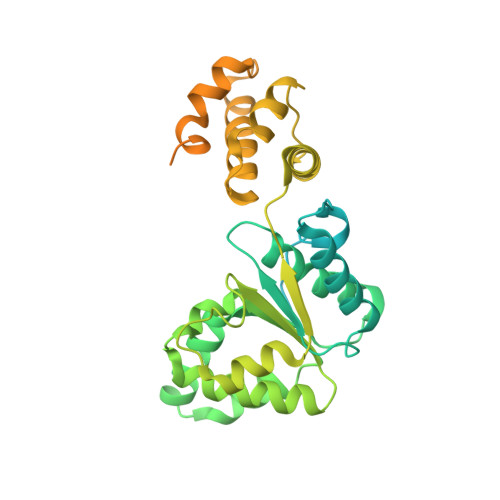A Common Mechanism for the ATP-DnaA-dependent Formation of Open Complexes at the Replication Origin
Ozaki, S., Kawakami, H., Nakamura, K., Fujikawa, N., Kagawa, W., Park, S.-Y., Yokoyama, S., Kurumizaka, H., Katayama, T.(2008) J Biol Chem 283: 8351-8362
- PubMed: 18216012
- DOI: https://doi.org/10.1074/jbc.M708684200
- Primary Citation of Related Structures:
2Z4R, 2Z4S - PubMed Abstract:
Initiation of chromosomal replication and its cell cycle-coordinated regulation bear crucial and fundamental mechanisms in most cellular organisms. Escherichia coli DnaA protein forms a homomultimeric complex with the replication origin (oriC). ATP-DnaA multimers unwind the duplex within the oriC unwinding element (DUE). In this study, structural analyses suggested that several residues exposed in the central pore of the putative structure of DnaA multimers could be important for unwinding. Using mutation analyses, we found that, of these candidate residues, DnaA Val-211 and Arg-245 are prerequisites for initiation in vivo and in vitro. Whereas DnaA V211A and R245A proteins retained normal affinities for ATP/ADP and DNA and activity for the ATP-specific conformational change of the initiation complex in vitro, oriC complexes of these mutant proteins were inactive in DUE unwinding and in binding to the single-stranded DUE. Unlike oriC complexes including ADP-DnaA or the mutant DnaA, ATP-DnaA-oriC complexes specifically bound the upper strand of single-stranded DUE. Specific T-rich sequences within the strand were required for binding. The corresponding conserved residues of the DnaA ortholog in Thermotoga maritima, an ancient eubacterium, were also required for DUE unwinding, consistent with the idea that the mechanism and regulation for DUE unwinding can be evolutionarily conserved. These findings provide novel insights into mechanisms for pore-mediated origin unwinding, ATP/ADP-dependent regulation, and helicase loading of the initiation complex.
Organizational Affiliation:
Department of Molecular Biology, Graduate School of Pharmaceutical Sciences, Kyushu University, Fukuoka, Japan.
















